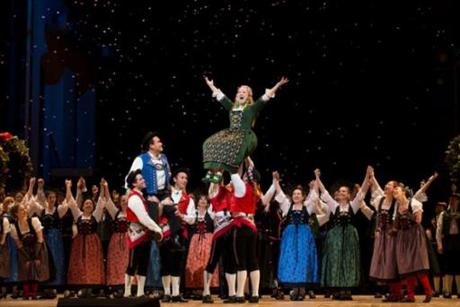 Diana Damrau (center) and Javier Camarena (left) in La Sonnambula (Photo: Jonathan Tichler / Met Opera)
Diana Damrau (center) and Javier Camarena (left) in La Sonnambula (Photo: Jonathan Tichler / Met Opera)Figaro Here, Figaro There, Figaro Everywhere
How much has the modern operatic repertoire changed over the years? How about the last half-century or more? Consulting one of my prized possessions, the Metropolitan Opera Guild’s 1948 edition of the Opera Lover’s Companion, I was astonished to find the list of bel canto pieces produced by the Met during the postwar years to be almost nonexistent in comparison to present-day offerings.
Back when this book was compiled, the sheer number of operas that could be classified as belonging to the bel canto repertoire was undeniably miniscule. The mainstay for this category was held together by a handful of works, primarily Rossini’s The Barber of Seville and Donizetti’s Lucia di Lammermoor, albeit in greatly truncated and/or reduced forms.
On occasion, one might be privileged to hear L’Elisir d’Amore (“The Elixir of Love”), also by Donizetti, or his comic masterwork, Don Pasquale. Fans eagerly awaiting something more besides The Barber would be treated to Rossini’s other rollicking farce, i.e., La Cenerentola, based on the Cinderella story. Of course, when a vocal attraction of the Gina Cigna or Zinka Milanov variety could be found, then Bellini’s Norma would be dusted off and trotted out for audience appreciation. And that, opera lovers, was that!
Some say the war years had shattered what little taste was left for the lost art of “beautiful singing.” As we entered the 1950s, things started to look up for bel canto, thanks in large part to several factors. First, this happened to be a most fertile period of rediscovery and revival, where a studied musician of the quality of conductor and author Vittorio Gui, for example, would champion such neglected Rossinian staples as the aforementioned La Cenerentola, Il Turco in Italia, Mosè in Egitto, and L’Italiana in Algeri in their original (or as close to their original) form as was humanly possible.
In the case of Il Barbiere di Siviglia, the coloratura role of Rosina would be sung not by a chirpy soprano, as was the norm, but by the lower-voiced mezzo or contralto, and performed — and this was the main ingredient — in the original key by artists more or less capable of executing the rapid runs and stylistic flourishes associated with the part. Another crucial element was the restoration of previously excised material. Such was the situation with, say, Count Almaviva’s Act II aria, “Cessa di più resistere,” which had been cut even in Rossini’s day and partially recycled (as was the composer’s wont) as “Non più mesta,” an elaborate showstopper for the character of Angelina in the finale to La Cenerentola.
Still another factor was the arrival of stereophonic long-playing records, which touted the ability of this new-found technology to capture and preserve uncut presentations of operas that had been previously decimated in stage performance. A great example of this were the first “note complete” albums of Lucia di Lammermoor: first, the 1959 RCA Victor recording with Anna Moffo, Carlo Bergonzi, Mario Sereni, and Ezio Flagello, conducted by Georges Prêtre; followed by the 1961 Decca/London version, with a young Joan Sutherland, Renato Cioni, Robert Merrill, and Cesare Siepi, with maestro John Pritchard on the podium. Both albums can be commended for presenting Lucia in a way most listeners had never experienced before.
Today, we take projects such as these for granted. We should consider ourselves lucky, then, to have heard many of these cherished operas in as close an approximation to the accepted bel canto style as the human voice was then capable of – given the right type of artist, that is.
Trouble in Paradise
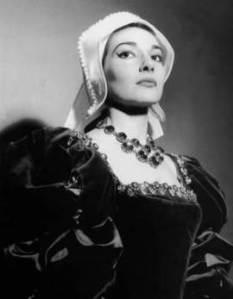
But there was a problem with bel canto when it reemerged in the early 1950s. Part of the concern was that few singers at the time had the vocal agility or requisite technique to give life to the long lines and ornate passages these operas demanded of them. While it was true that an insightful interpreter such as Maria Callas might have coped, dramatically and vocally, with the requirements of Donizetti’s Anna Bolena and Bellini’s Norma, or a Giulietta Simionato may have tackled Angelina or Rosina with the assurance and aplomb of a pro, not every cast member was up to the challenge.
However, let it be said that once opera was graced with the presence of Joan Sutherland, Montserrat Caballé, Leyla Gencer, Beverly Sills, Marilyn Horne, Teresa Berganza, Fiorenza Cossotto, Alfredo Kraus, Luciano Pavarotti and others, bel canto took a major turn for the better.
Looking at the male side of the equation for a moment, while such lighter-voiced singers as Luigi Alva, Nicola Monti, Renato Cioni, and Cesare Valletti were fine as far as they went (we may add the more robust tenor tones of Mario Filippeschi and Gianni Raimondi to the roster), other categories involving baritones and basses had more than their share of difficulties. A Tito Gobbi or a Gino Bechi, for instance, may have been perfectly suited to Verdi and Puccini, or to the heavier verismo repertoire. But in bel canto, where lightness of tone, care for the legato line, and vocal dexterity were the order of the day, with few exceptions they would be basically at sea.
Once in a while, a singer would come along, i.e., Rolando Panerai, Enzo Sordello, Piero Cappuccilli or Renato Bruson, who could manage to “get by” and eventually acquit himself bravely, if not nobly. But the likes of the steely-voiced Ettore Bastianini (in Donizetti’s Poliuto, opposite Franco Corelli and Maria Callas) and others from their generation would more often than not encounter the greatest of hurdles in performing such flowing parts as King Alfonso in Donizetti’s La Favorita, Riccardo in I Puritani, or even Enrico Ashton in Lucia di Lammermoor.
To site one more case in point, let’s take the luxurious basso cantante role of King Henry VIII from Anna Bolena. Who did opera houses have in the fifties and sixties to properly portray the randy English monarch, both vocally and physically? To my knowledge, there were Nicola Rossi-Lemeni, Nicolai Ghiaurov, and, most passably, Cesare Siepi. Not to take anything away from these outstanding singing actors, but bel canto fireworks (with the paradigm of Siepi’s Don Giovanni and Marriage of Figaro uppermost in our thoughts) was most definitely not in their natural makeup.
The Three Musketeers of Opera
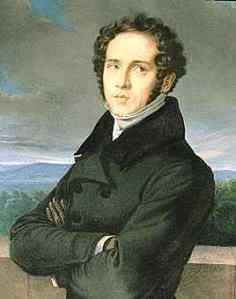
Which brings me to the veritable feast of “beautiful singing” listeners were treated to in the various Met Opera broadcasts of Bellini’s La Sonnambula (March 29), the same composer’s I Puritani (May 3), and Rossini’s La Cenerentola (May 10), the last broadcast of the 2013-2014 radio season. To the above list, let us also mention the Live in HD rebroadcast of Donizetti’s perennial Lucia di Lammermoor from March 2011, which aired during August 2014.
Still, if you’re going to discuss the bel canto era with any authority, you must first bring up the incomparably talented Vincenzo Bellini. Born in Catania, Sicily, in 1801, Bellini was without a doubt the quintessential bel canto composer. What Chopin did for the piano, Bellini had done for the voice. During a ten-year period between 1825 and 1835, he produced no less than five major stage works (Il Pirata, La Sonnambula, Norma, Beatrice di Tenda, I Puritani) and six minor ones. Sadly, he was struck down in his prime by general peritonitis, not two months shy of his 34th birthday, indeed a tragic blow to opera.
Be that as it may, the acknowledged elder statesman of the art was the congenial Gioachino Rossini (1792-1868). A man of voracious appetites and sensual tastes, Rossini was a natural-born spinner of tunes. His “calling card,” as it were, was his ability to compose at a hurried pace, and at every opportunity apply the crescendo to his musical output. Practically all of Rossini’s best-known overtures, along with his inspired ensemble displays — from his earliest operas La Cambiale di Matrimonio (“The Marriage Contract”), Il Signor Bruschino and Tancredi, to the immortal Barber of Seville, La Gazza Ladra (“The Thieving Magpie”), Semiramide, and his final statement on the subject, Guillaume Tell (“William Tell”) — featured this signature technique.
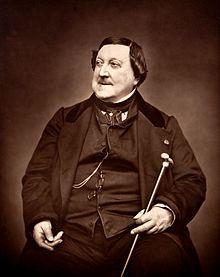
Bellini was still a young boy when Rossini was receiving wide acclaim throughout the theater world of Venice, Naples and Milan. In fact, prior to the advent of Bellini’s mature oeuvre — the first of which was the successful Il Pirata, given in 1827 (to be exact, his first operatic attempts, Adelson e Salvini from 1825 and Bianca e Gernando from 1826, were fair to middling efforts) — Rossini’s only active competition came from his contemporary, Gaetano Donizetti (1797-1848), from the province of Lombardy, a composer just as prolific if not as insanely driven as his foremost rival.
We’ve touched upon the distinctiveness of both Donizetti and Rossini’s artistry in previous posts (see the following link: http://josmarlopes.wordpress.com/2013/02/10/lelisir-damore-the-elixir-of-love-old-wine-in-a-new-bottle/). Let it suffice that Signor Gioachino was the uncrowned king of comedy (Beethoven had famously charged the Italian with providing the world with “more Barbers”), whereas the bulk of Donizetti’s endeavors effectively traversed the realm of tragedy.
Readers may or may not be aware that after the gala debut of his masterpiece, the French grand opera Guillaume Tell, in 1829, the thoroughly sated Rossini ended his operatic career. With the exception of his Stabat Mater, a religious choral work begun in 1832, and completed in 1841, in addition to several salon pieces written for his own amusement, Rossini put down his pen and retired to Paris, France, to the life of a gourmand and master chef. Bon appétit!
Bellini’s premature passing and Rossini’s abdication should have cleared the way for the last of the towering figures of Italian bel canto, Gaetano Donizetti, who conducted the 1842 premiere of Stabat Mater in Bologna. There, he finally met his illustrious compatriot, Rossini. By the way, the two gentlemen hit it off smartly. After receiving the master’s blessing, Donizetti traveled to Vienna where he assumed the post of Kapellmeister, or “house composer,” to the Austrian court.
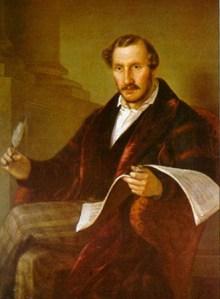
Regrettably, the syphilitic and manic depressive Gaetano soon became incapacitated by his many ills. In declining health, Donizetti had been diagnosed in Paris with mental instability and was urged to relocate to Bergamo, the place of his birth, where he died on April 8, 1848, at age 50. By sheer coincidence, Donizetti had been privy to more than a few productions of the seminal works of a young composer named Giuseppe Verdi.
Verdi was deeply influenced by all three geniuses, but his greatest inspiration was drawn from close contact with Donizetti and Rossini’s finest creations, most notably Lucia di Lammermoor and La Favorita, as well as Guillaume Tell. Can anyone not see the similarity between Lucia’s opening scena and Leonora’s “Tacea la notte placida” from Il Trovatore? Or Arnold’s air, “Asile héréditaire” and rousing cabaletta from Guillaume Tell, with Manrico’s lovely “Ah, si, ben mio” and exhilarating call-to-arms, “Di quella pira,” also from Trovatore?
And if any composer was capable of rescuing opera from total oblivion, surely Verdi was that man. He became, in quick order, the literal embodiment of the very best of bel canto formerly represented by Rossini, Donizetti and Bellini, the trio that developed and preserved Italian opera for posterity.
Sleepwalking with the Stars
So what made bel canto so special? That would depend on who was doing the composing. With all three composers, it was a singular marriage of text to song, the way the emotional content of these works was expressed not just through the music or voice but through words as well. With Bellini, it was what has been termed his “three-part invention” — that is, a healthy dollop of orchestra-supported recitative, a slow-moving cavatina of achingly lovely melody, and a fast and furious final stretch called the cabaletta.
These seem like the standard bel canto construction for any number of set pieces, one which Bellini particularly excelled at. The task of, and challenge for, any singer who undertakes a Bellini role is to capture the many nuances called for in the text and to effortlessly transition from one emotional content to the other in as smooth a manner as possible. Furthermore, the seams that bind these transitional passages must never be shown. If they are, then the musical line is ruined, and the effect that bel canto composers have so carefully and artfully constructed goes for naught.
To further illustrate our point, we need only site the Saturday Met Opera broadcast of La Sonnambula, on March 29. One could hear, in the performances of the titular sleepwalker, Amina, by German soprano Diana Damrau (previously heard at the Met as Gilda in Rigoletto and Violetta in La Traviata, both by Verdi), and Mexican star tenor Javier Camarena as Elvino, a bravura display of coloratura high-wire antics blended with artistry and élan.
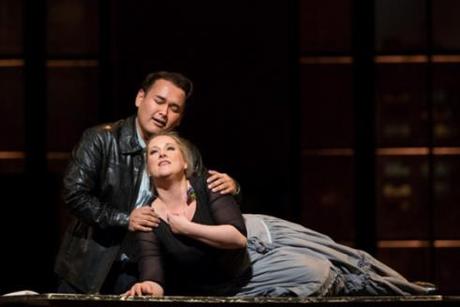
To find two such fabulously gifted singers who can overcome most, if not all, of this opera’s many vocal hazards, was both a pleasure and a privilege. As expected, Damrau was superb throughout, flawlessly shaping the line and caressing the notes for greatest dramatic impact, in addition to perfectly executed cadenzas. Similarly, Camarena received the loudest and most sustained applause of the afternoon for his sparkling rendition of Elvino’s high-lying music. He also sang softly when called for, a major plus. Physically, the pair was well-matched. As Count Rodolfo, Italian bass Michele Pertusi’s dark-toned portrayal fulfilled all the requirements of his role with poise and grace. The opera was presided over in fine fashion by conductor Marco Armiliato, the Met’s resident expert on all things Italian.
Moving on to the May 3 broadcast of I Puritani, the listener was amply rewarded with an all-star lineup of talents. Starting with debuting Russian soprano Olga Peretyatko as Elvira, one of those flighty Romantic heroines who go in-and-out of madness (in the mold of Donizetti’s Lucia, but without that opera’s tragic consequences), and continuing with the amazingly adept Lawrence Brownlee in the near-impossible role of Arturo, followed by Polish baritone Mariusz Kwiecien as Riccardo, and our friend Pertusi as Sir Giorgio. The conductor for this performance was Michele Mariotti.
I must say that I have never heard Arturo sung in the way that Brownlee had delivered it. My word! It started with a heavenly “A te, o cara,” and continued on to his duet with Enrichetta (voiced by mezzo-soprano Elizabeth Bishop). As we approached the finale, not even the late Pavarotti could have managed that fiendishly difficult third act aria, “Credeasi misera,” on stage, what with its inaccessible high F (sung either falsetto or “in the head”), not to mention those high C’s and D’s! That Brownlee made it and survived was miraculous in itself; that he acquitted himself well in almost all aspects of the part speaks highly for his abilities. His was a performance where every syllable was lovingly shaped, every word intelligibly and thoughtfully expressed, and every sound emitted a throwback to the golden age of bel canto singing. Bravo, bravissimo!
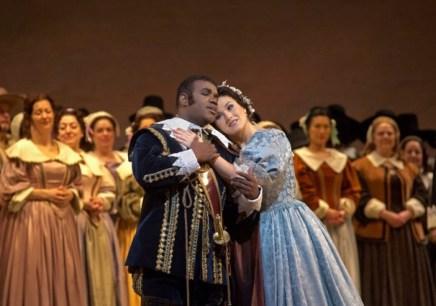
Soprano Peretyatko’s Elvira was new to me. In voice and looks, she reminded one of Anna Netrebko, the Met’s reigning queen of opening nights. There is much to be said for that resemblance, but at this early stage in her career Peretyatko needs more stage experience to be able to compete on a level playing field with her Russian counterpart. With that said, I heard many good things in her recent assumption — nothing spectacular, to be truthful, but the raw material is there: carriage, phrasing, expressiveness, and care for note values. Olga must strive to overcome any tendencies that would make her a mere “clone” of the more established Netrebko. In all, we can expect great things from this comely newcomer. I’m told that Peter Gelb, the Met’s general manger, believes it as well.
As for the others in the cast, Kwiecien had come off a recent bought of the flu. Still under the weather, he missed (or ducked) the high note usually called for in the stirring duet, “Suoni la tromba intrepido,” with bass Pertusi that closes Act II. Otherwise, I got the feeling Kwiecien’s voice can no longer sustain the agility demanded of the part of Riccardo. The ease of flow with which he formerly produced his long lines, combined with a lightness of touch, is a thing of the past. This is not necessarily bad news for his fans (me being one of them), just a realization that Kwiecien has matured as an artist, vocally and tonally; that he should consider taking on other assignments apart from bel canto. That is, roles that complement his current vocal state. Again, this is merely an observation colored by what was heard on this occasion.
(To be continued…)
Copyright © 2014 by Josmar F. Lopes

